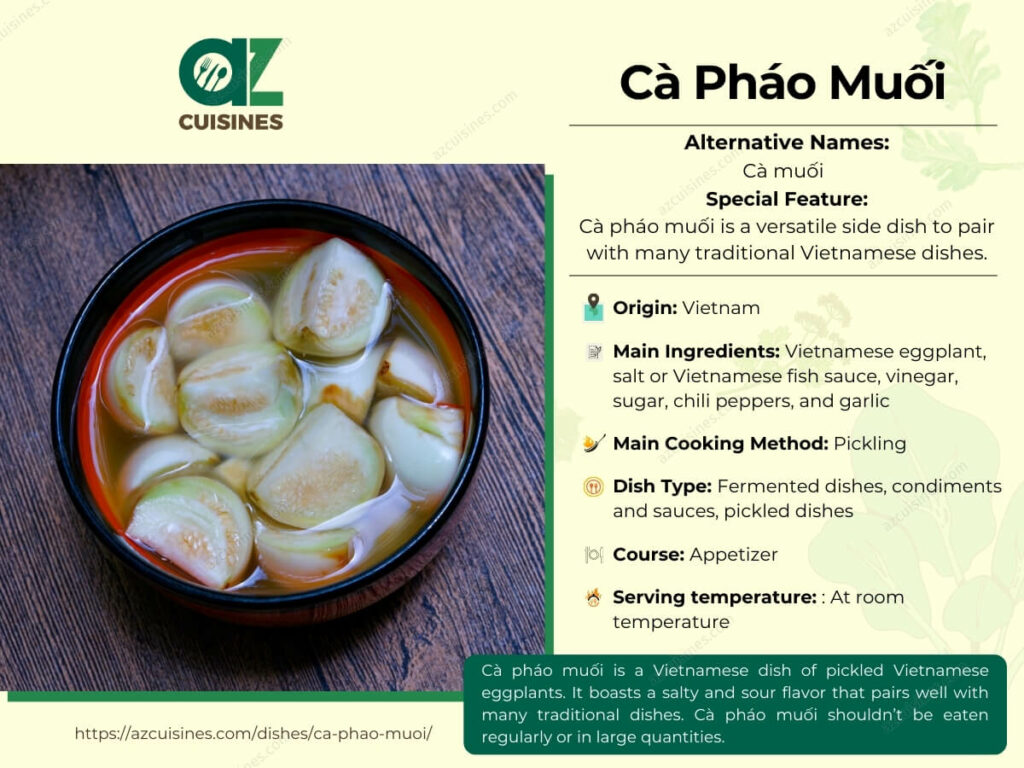#111 in Vietnam
Cà Pháo Muối: Basic Information
Pronunciation
/cah fow moo-oy/
Alternative Name(s)
Dish Type
Course
Mealtime
Popular Variations
Cà Pháo Muối: Ingredients and Preparation
Main Ingredients
Main Cooking Method
Preparation Process
Cà Pháo Muối: A Deep Dive
Cultural Significance
Taste
Texture
Aroma
Color
Serving Style
Serving Temperature
Accompaniment
Occasions
Seasons
Special Diets
Calories
Popularity
Popular Similar Dishes
- Suan Cai
- Torshi
- Tsukemono
Popular Dining Area
Cà pháo muối, or cà muối, is a Vietnamese dish prepared by pickling Vietnamese eggplants (Solanum macrocarpon) in a salty and sour liquid.
The pickling liquid consists of salt or Vietnamese fish sauce, vinegar, sugar, chili pepper, garlic, and additional spices like ginger or lesser galangal (Alpinia officinarum).
There are two main ways to prepare cà pháo muối: muối xổi (quick pickling) and muối chua (literally “fermented pickling”).
Muối xổi only takes 1 – 2 days to prepare, while muối chua can take 1.5 – 2 weeks to be ready. Generally, muối chua is considered a safer method.
Unripe Vietnamese eggplants contain toxins, so only ripe ones are good for pickling. Crunchy and savory cà pháo muối is a popular dish to serve with rice, boiled vegetables (especially water spinach), boiled pork, etc.
Nevertheless, this Vietnamese specialty shouldn’t be consumed in large quantities.
I will introduce you to the method of making cà pháo muối as well as the advantages and disadvantages of this dish. Next, I will delve into common concerns about this dish and suggest similar dishes.
Key Points
How to Make Cà Pháo Muối?
The preparation of cà pháo muối involves the following 4 steps.
| Step | Instruction |
|---|---|
| Cleaning the Vietnamese eggplants | Cutting off the stems of the Vietnamese eggplants Soaking them in lightly salted water for a few hours Letting the Vietnamese eggplants drain Cutting the Vietnamese eggplants in half (optional) |
| Preparing the pickling liquid | Mincing or slicing finely the herbs and spices Boiling fish sauce, sugar, salt, and vinegar in water over low heat |
| Assembling cà pháo muối | Layering the Vietnamese eggplants with the herbs and spices or mixing everything carefully in a glass jar Pouring the pickling liquid into the jar and ensuring that the eggplants are completely submerged |
| Pickling cà pháo muối | Putting the jar in the fridge Leaving the jar alone for 1 – 2 days (muối xổi) or 1.5 – 2 weeks (muối chua) |
As I mentioned above, pickling cà pháo muối for only 1 – 2 days can lead to many negative effects and limit the benefit of this dish. Read on for an in-depth look at the upsides and downsides of cà pháo muối.
Pros and Cons of Eating Cà Pháo Muối
Cà pháo muối has the following benefits and challenges.
Pros
Cons
Cà pháo muối is a healthy dish for many people but unsafe for others. I will tell you about who should or shouldn’t eat this Vietnamese pickled dish and other facts in the FAQs section.




Truc Tran (Kris)
Senior Food Editor
Expertise
Home Cooking, Meal Planning, Recipe Development, Baking and Pastry, Food Editor, Cooking-video Maker, Vietnamese Food Evaluation Expert
Education
Truc Tran (Kris), an experienced food writer and editor, is great at exploring and describing global cuisines, from simple street food to fancy dining. In her writing, she skillfully mixes different flavors, cooking methods, and culinary traditions, showing the unique character of various cultures through their food and drinks. On azcuisines.com, Kris highlights her knowledge, especially in Asian cuisine and worldwide traditional dishes.